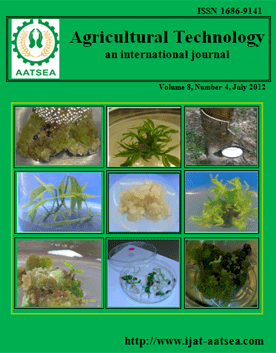ThaiScience
ThaiScience
INTERNATIONAL JOURNAL OF AGRICULTURAL TECHNOLOGY
Volume 16, No. 05, Month SEPTEMBER, Year 2020, Pages 1243 - 1256
Chemical composition and bioactivity of essential oil from indian borage (plectranthus amboinicus (lour.) spreng) against callosobruchus maculatus (f.)
Satongrod, B. and Wanna, R.
Abstract Download PDF
Cowpea weevil, Callosobruchus maculatus (F.), is a major insect pest of mungbean causing extensive damage to both quantity and quality. Application of synthetic insecticides to control this insect has a negative effect on human health and the environment. Essential oils from natural plants are recognized as user and environmentally friendly alternatives. Chemical compositions of the essential oil from Indian borage leaves, Plectranthus amboinicus (Lour.) Spreng, were analyzed by Gas Chromatography-Mass Spectrometry (GC-MS), and fumigation toxicity of P. amboinicus essential oil was evaluated using the vapor-phase test. The main components were carvacrol (71.41%), followed by caryophyllene (7.19%), p-cymene (4.46%), caryophyllene oxide (3.52%), trans-bergamotene (2.53%), humulene (2.26%) and terpinolene (2.16%). The LC50 values of fumigation toxicity to C. maculatus at 24, 48 and 72 h were 7.18, 5.78 and 5.11 μL/L air, respectively. Killing efficiency of 100% adult mortality of C. maculatus was found after 24 h of exposure with 15 μL/L air, while 1 μL/L air of P. amboinicus essential oil had repellent effect on adult C. maculatus of 87.50% within 48 h. Results showed that P. amboinicus essential oil showed a potential as an alternative method to control C. maculatus infestations.
Keywords
Lamiaceae, Chemical compounds, Toxicity, Plant essential oils, Stored insect pestsINTERNATIONAL JOURNAL OF AGRICULTURAL TECHNOLOGY
Published by : Association of Agricultural Technology in Southeast Asia (AATSEA)
Contributions welcome at : http://www.ijat-aatsea.com
